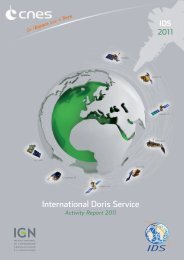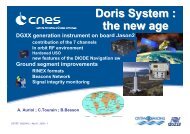The International DORIS Service July 2003 – December 2005 report
The International DORIS Service July 2003 – December 2005 report
The International DORIS Service July 2003 – December 2005 report
Create successful ePaper yourself
Turn your PDF publications into a flip-book with our unique Google optimized e-Paper software.
IDS Report <strong>–</strong> <strong>July</strong> <strong>2003</strong> to <strong>December</strong> <strong>2005</strong> 56<br />
13 REPORT OF THE OBSERVATORY PECNY ANALYSIS CENTER<br />
Petr Stepanek (1), Urs Hugentobler (2), Karine Le Bail (3)<br />
(1) Geodetic Observatory Pecný, Czech Republic<br />
(2) AIUB, Switzerland<br />
(3) IGN, France<br />
In a cooperation among the AIUB (Astronomical Institute, University of Bern), the GOPE<br />
(Geodetic Observatory Pecný) and the IGN (Institut Géographique National), <strong>DORIS</strong> data<br />
analysis capabilities were implemented into a development version of the Bernese GPS<br />
Software. <strong>The</strong> <strong>DORIS</strong> Doppler observables are reformulated such that they are similar to Global<br />
Navigation Satellite System (GNSS) carrier phase observations allowing the use of the same<br />
observation models and algorithms as for GNSS carrier phase data analysis with only minor<br />
modifications.<br />
Sophisticated dynamical models for non-conservative forces on <strong>DORIS</strong> carrying satellites are<br />
not yet fully available in the current development version. For the experiments, daily orbit arcs<br />
were modeled with six Keplerian elements as well as with nine empirical parameters (3 constant<br />
and 6 once-per-revolution accelerations) with loose constrains (1x10 <strong>–</strong>6 ms-2). Remaining model<br />
deficiencies were mitigated by estimating stochastic parameters (equivalent to velocity changes)<br />
in radial, along track and cross track directions (only in radial direction for TOPEX). <strong>The</strong><br />
constrains on the stochastic parameters and the intervals were adapted such that the RMS of<br />
the estimated orbits with respect to POE precise orbits was minimized. With stochastic<br />
parameters at intervals of 15 minutes, optimum constrains were 6x10 -5 ms-1 for the radial and<br />
cross track directions, and 3x10 -5 ms-1 for the along track direction. For TOPEX, no<br />
improvement of the orbit was achieved using the stochastic parameters in along track and cross<br />
track direction, therefore stochastic parameters were used only in the radial direction. No air<br />
drag parameters were estimated.<br />
<strong>The</strong> results of network and pole estimation of three weeks of <strong>DORIS</strong> data (September 2004, five<br />
satellites) at GOPE are promising and of a slightly lower quality than corresponding solutions<br />
routinely computed within the IDS (LCA, IGN). <strong>The</strong> weekly coordinate repeatability RMS is of<br />
the order of 2-3 cm for each station coordinate. Comparison with corresponding estimates of<br />
stations coordinates from current IDS Analysis Centers demonstrates closed precision (figure<br />
20). Daily pole components estimates show a mean difference from IERS C04 of 0.6 mas in Xp<br />
and -0.5 mas in Yp and standard deviation of 0.8 mas in Xp and 0.9 mas in Yp (mean<br />
removed). An automatic analysis procedure is under development at GOPE and routine <strong>DORIS</strong><br />
data processing is planed to start before the end of the year 2006.






